A new survey helps explain why city leaders have been putting better sidewalks and crosswalks at the center of their push for new transportation funding: it’s the issue voters say would be most likely to win them over.
A whopping 86 percent of Portlanders polled last month said the presence of “sidewalks and safety features in places where children need them to get to school and seniors need them to get to transit” would make them more likely to support a new city transportation revenue package. The second most popular issue, with 84 percent support, was “more crosswalks and flashing light signals on streets with dangerous intersections and bus and transit stops.”
Protected bike lanes, by contrast, were less universally popular. 64 percent of Portlanders said they’d be more likely to support a package that “created bike routes that separated people riding bicycles from car and freight traffic.”
The issue on the list that Portlanders found least moving: paving the city’s unpaved and gravel streets. 60 percent of Portlanders say they’d be more likely to support a funding package that included gravel street paving, and 36 percent said they’d be less less likely.
Here’s the full list of issues the city presented, with green bars representing the most important to winning Portlanders’ support. Click to enlarge:
Public concern about pedestrian safety has grown “significantly” since a similar poll in 2007, pollster Adam Davis found. His “seven takeaways” from the survey are in this slideshow.
“In 2007, about two out of three people said more crosswalks on streets with bus and transit stops would increase their support for funding,” the city said in its Monday news release. “Now, more than eight in ten say the same thing. By contrast, feelings about the need for long delayed maintenance that will reduce the future costs of road and bridge repairs have remained steady at three-quarters support.”
Portlanders’ relative lack of enthusiasm for paving unpaved streets shouldn’t be confused with their support for maintenance of paved streets, especially major ones. When the poll gave Portlanders an open-ended question of what the city’s “biggest transportation-related needs” would be, here’s what they said (the circles are the pollster’s):
Finally, here’s a third chart, reflecting voters’ answers to a question that asked them to rate various priorites from 1 to 7:
The results were based on a survey of 800 Portlanders. The results are multi-faceted; expect more coverage over the coming weeks (and expect different news outlets to interpret the same survey in different ways).
We’ve focused here on the question of what issue is most likely to sway voters because that’s the most pressing issue at hand for the city. As we’ve been reporting, the city is gathering public opinion and insight in an effort to approve a new transportation funding source later this year, either by council or public vote.
Three town halls later this month will also give the public a chance to learn about the subject and weigh in:
- Thursday, Feb. 20, 6:30 to 8:30 p.m. at Sunnyside Environmental School, 3421 SE Salmon St.
- Tuesday, Feb. 25, 6:30 to 8:30 at Immigrant & Refuge Community Organization (IRCO), 10301 NE Glisan St.
- Thursday, Feb. 27, 6:30 to 8:30 p.m., Multnomah Arts Center, 7688 SW Capitol Highway
Members of the public can also contact Mark Lear at (503) 823-7604 or mark.lear@portlandoregon.gov for more information.

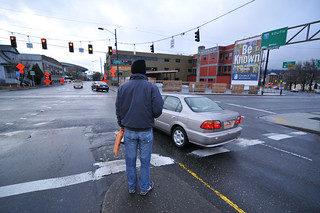
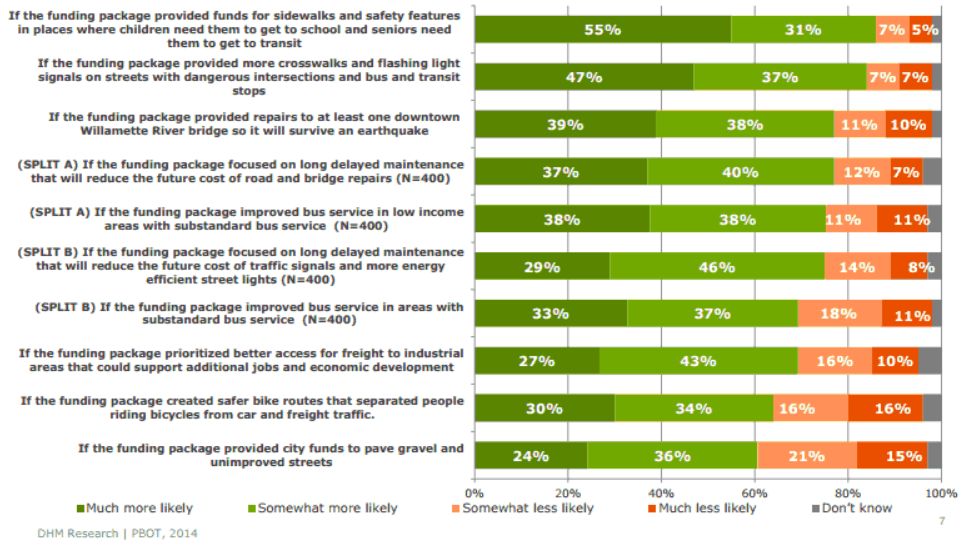

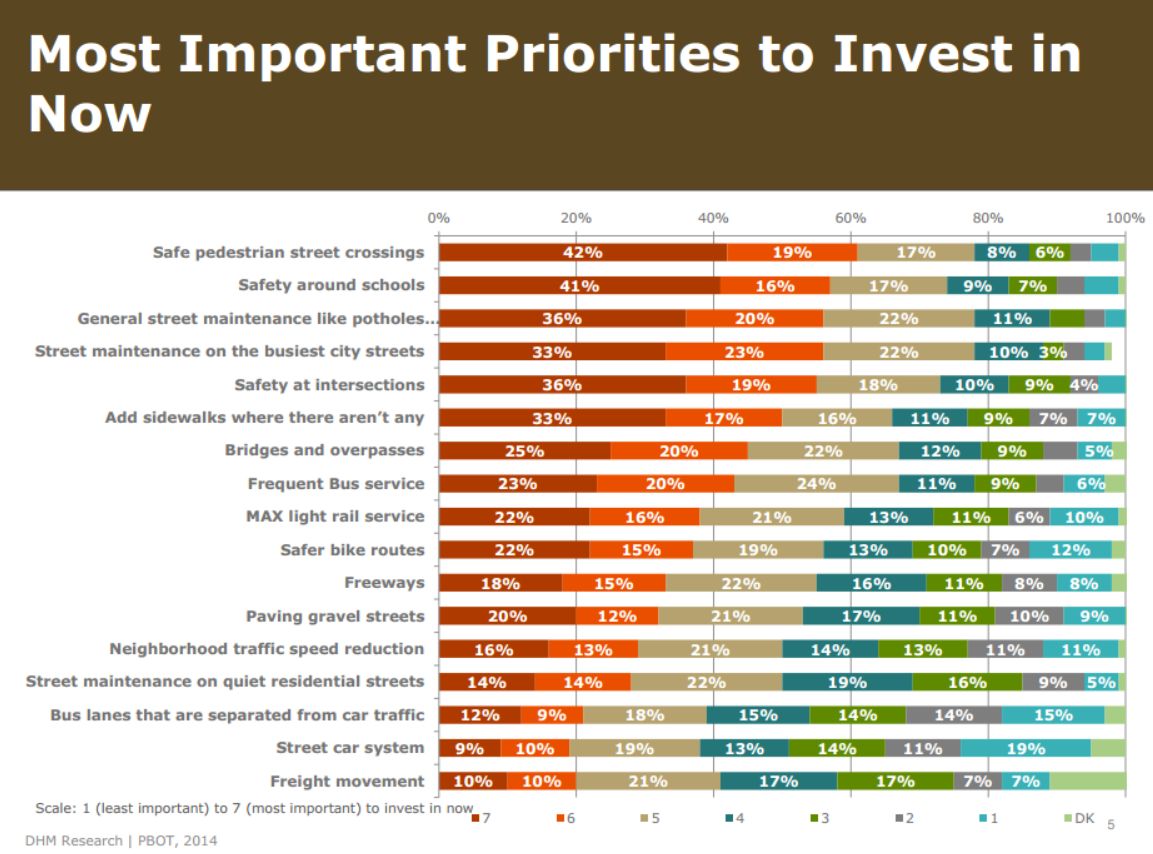
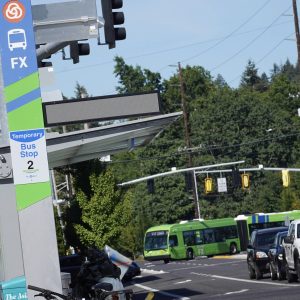
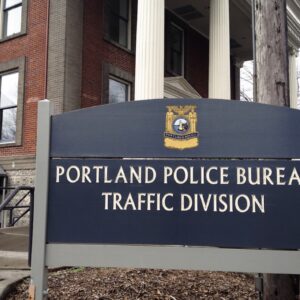

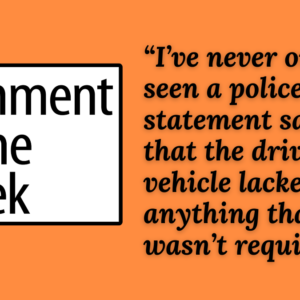
Thanks for reading.
BikePortland has served this community with independent community journalism since 2005. We rely on subscriptions from readers like you to survive. Your financial support is vital in keeping this valuable resource alive and well.
Please subscribe today to strengthen and expand our work.
Funny, I just read about the poll results in the O. Made no mention of this fact. Shocking!
Which fact? 🙂
In our neighborhood visioning, pot holes and pavement was mentioned a few times.
Safe bike and pedestrian routes to schools parks and the MAX was mentioned repeatedly. So, this comes as no surprise to me.
I think this has to be neighborhood dependent, as at our visioning last year we had A LOT of talk about paving unimproved roads. But we have a lot of those in our neighborhood. I think it’s probably out of sight out of mind for many in Portland. Sad that is feel so far down the list (granted it’s pretty hard to pick from these as they are all worthy of money).
Sorry, “Sad that it fell so far down the list”
It very much is neighborhood dependant, hence why any new fee or tax should funnel back into the neighborhoods based on population and what their needs are. Some needs are very speciifc…as in we are the only neighborhood without a school, yet there are not even safe routes to get to the ones a few blocks away in the next neighborhood. Hence, why safe bike routes and corssings were mentioned repeatedly.
Visioning has been dis-credited as a method of getting good ideas. There is a body of academic study on this issue (group think, visioning, brainstorming). When SE Uplift does “visioning” it is worthless. The results of the visioning session in my neighborhood association read like the rantings of someone on acid, yet all the participant were cogent and sober. Visioning is replaced by less associative, more scientific methods by academics who are serious at getting input. For instance, Apple doesn’t use “visioning” to gauge consumer sentiment because visioning doesn’t yield useful data.
Sure, but it’s a pretty easy, fast, and cheap way to just get a rough gauge on what is on people’s minds.
A rough gauge is not good enough. A properly drafted survey is no more expensive, no harder, and no slower than a survey with emotional words
and jargon.
I think a “properly drafted survey” is all of those things. A visioning session is about as cheap and easy you can get. Just get a bunch of people in a room and ask them to describe and list things. What your proposing costs the time (and potentially the writer is doing this for a profession, so cost) to write up a survey.
Even if visioning doesn’t get good ideas. It at least is a very grassroots poll to see what is on people’s minds. If 8 people out of 30 have listed that they don’t like that their neighborhood has unpaved streets, you at least have a basis to believe that that is an issue that people have with the neighborhood.
So I’m assuming you think that NA’s should get together and give their residents a survey (which we’ve already discussed here can be biased and skewed based on the wording of questions)? Sure visioning gets some nuts, but that’s how the public process is.
Visioning yields no good data, Dave. Might as well use a ouija board, or
do a horoscope for the neighborhood. There is a body of academic research that supports my position. Why use a dis-credited bs technique at all? It mis-leads people.
So- let’s do a tarot reading for Lents. Just as good as “visioning.”
The Federal Highway Administration apparently disagrees with you. http://www.fhwa.dot.gov/livability/case_studies/guidebook/chap02.cfm
I’m interested if you would share your sources.
Dave, the January 30, 2012 issue of the New Yorker provides a good introduction to why brainstorming and visioning yields unusable data.
I know that you have areas of expertise, but so do I. In this particular area, you are wrong. It may be counter intuitive, but “visioning” is a bad idea. There are better cheap methods than visioning. And, like horoscopes and tarot cards, they can create a false sense of knowing something.
Again, I am sure there are things about infrastructure that you understand better than I do. But I have professional experience in the area of questions/surveys.
http://www.newyorker.com/reporting/2012/01 30/120130fa_fact_lehrer?currentPage=all
Thanks that’s what I was looking for.
The link was broken, do you have a title for the article
(and thanks for sharing that, I realize this is not my expertise, which is why I was interested in your sources).
It misleads people to what? Speak their mind about how they feel about a certain subject?
I’m sorry to drag this out, and I understand that often visioning won’t produce significant data, but I’m truly curious of why you think it’s completely worthless.
So to replace it your are proposing to always use surveys?
Dave, rather than visioning (which yields garbage data that says anything you want) you can just sit down and talk to people. “Dave, what are your transportation priorities? Mamacita, how do you feel about bike share?”
That is better than you and I “brainstorming” for the reasons laid out in the
New Yorker article. Debates produce better results than brainstorming, for reasons that have to do with psychology and group dynamics.
You can always have neutral questions and ask the group to vote.
It’s not a choice between voodoo and nothing. There are cogent ways to gauge the opinions of a group. A well-led discussion group is not more expensive than Southeast Uplift coming and producing some horrible sound poem of conflicting goals.
O.M. It’s interesting you chose Apple as an example – They are widely known for not using consumer focus groups, and instead just pushing a good idea they they think is great: “…people don’t know what they want until you show it to them.” – S Jobs
If anything, the “protected bike lanes everywhere” people have been using the apple approach: confidently pushing a new product you never even knew you needed.
Thanks for sharing that. I support people using logic and not hokey “visioning” sessions. I don’t disagree that sometimes people have to just push for something. It’s the voodoo hoodoo studies with kumbaya questions I dislike.
Let’s hope that Oregonian does not spin this into another round of cars vs. bikes. The idea that “repairing potholes and repaving” can’t benefit all road users including bicycles and pedestrians is nonsense for sure. But more people biking and walking is one of a number of strategies that can reduce the wear and tear on city streets and make our limited maintenance dollars go farther for everyone.
Yeah, the Oregonian did not use the word bike or bicycle or make any reference to these funny two wheeled creatures that people seem to enjoy using. Usually news orgs are supposed to add information from press releases, not hide the ones that they find inconvenient.
http://www.oregonlive.com/portland/index.ssf/2014/02/transportation_poll_finds_the.html#incart_river_default
…perhaps the ‘O’ was just trying to not inflame their readers vs. not inform?
Just so readers know: I wrote the first version of this post based entirely on the city’s analysis and press release. Once they released the full data, I updated with my own read on the most important findings here, changed the headline and added the images above.
Ummm am I the only one here noticing that separated bike infrastructure is 2nd to last on the list? Out of 10 options, Portland voters ranked it 9th. That’s a serious problem for separated bike infrastructure, which I strongly believe is the only way to get us past 10-15% mode share (not that we’re there now).
Yea but better/safer bike lanes scored 10%. Given that buffered bike lanes will probably simply be paint and, perhaps, a few planters that seems like a good number. How much is a lack of funding really holding up bike infrastructure? Particularly in places like downtown it’s a matter of having the political will to remove a travel lane or some parking.
I’m surprised how much love transit gets. If only TriMet weren’t so feeble!
Alex, I don’t know if most people were clear on the definition of “separated bike infrastructure” so the findings on support for bike infrastructure seem pretty murky. A flaw in the study’s design.
Probably true. And the wording was definitely suspect – I wonder how well “Safe and comfortable facilities for kids to bike to school on separated from car traffic” would have polled.
Exactly. It’s all in how you ask the question. The sidewalks question was the first one asked, the most detailed, and the only one that mentioned the political slam-dunks of children and seniors. Also, I don’t expect people to side strongly with separated bike infrastructure since they have almost zero experience with it. On the other hand, every single person who took this survey has experienced a sidewalk.
Or as they would be called in transpo-planner-ese: separated pedestrian infrastructure.
Jonathan, there are several professions where it is crucial to phrase a question correctly. For instance, when Pepsi does market research, they are actually quite scientific because they make more money with better
info. Lawyers and investigators understand that you ask simple, non-compound questions when you want the truth. Sociologists and
researchers and psychologists try and ask really good questions.
So, with all the science out there about how to ask a good question, why
did PBOT get a study that put in loaded words like “safety” and also technical jargon? I will tell you why: because if they asked good questions it would be harder to manipulate results.
Would you rather widen roads for the safety of children or build stupid bike lanes for jerks?
Adam H.- you have a bright future with the city of Portland! You know how to draft the perfect bad question. Do you support another street car, or do you prefer that kittens be mis-treated?
Sometimes I think these facilities design level surveys directed at the general public need to be drawn up as pictures.
Outside our insular circles of bicycle “subculture” and transportation engineering [a lot of us are armchair transportation engineers 😉 ] the average person doesn’t know the difference between a cycle track, a bike lane, a bike path or any of the other variations of bicycle facilities that might be a good idea that everyone would agree with.
Perhaps it would be a good idea to try to fix remove as many potentially biasing words from survey questions by laying out infrastructure questions in simplfied pictures.
I also doubt many people are very aware of what a cycle track is, and how, designed and located well, it could be used for a very appealing, functional amenity for walking, biking, skateboarding, etc, as fundamentally practical, rather than recreational use.
At the recent Washington County transportation plan open house, the likelihood this is true, was emphasized as I talked to a few officials present. When I said that phrase, ‘cycle track’, they paused, searching; there was some familiarity with examples across the pond, but not much in terms of how cycle tracks could possibly be used well in our area.
I think it’s very important to acknowledge that, with some caveats, motor vehicle travel is here to stay for the long run. Very importantly though, as it seems these surveys indicate, people are feeling it’s increasingly important to have walking and biking infrastructure, better perhaps, than some of the conventional examples that have been the standard for decades gone by.
Totally agreed that the sidewalks question in the first chart above was the most detailed and the only one that included the powerful “seniors”/”children” buzzwords. But the freight question included the powerful “jobs”/”economic development” buzzwords and didn’t do very well at all … and crosswalks came out on top of the third chart without any emotional heartstrings. Also, the sidewalk question wasn’t actually the first one asked; all of these were randomized for the poll.
But in general, I’d also say that the way you phrase the question is all-important. This poll was both a test of public opinion and a test of possible messages.
Better question:
Not all transportation options can be fully funded every year.
If you had to choose four lower priority issues, which would they be?
1. pave gravel roads
2. sidewalks
3. bike lanes on city streets
4. paved trails like the Springwater Corridor
5. streetcars
6. bike share
7. pot holes/ curbs
8. improvements to reduce storm water
(plants near storm drains)
9. pedestrian crossings with flashing lights
10. the Max
11. bus service
12. commercial truck access/freight
What are your top six priorities and why?
Does that feel neutral to you? The numbering should probably be random- I wouldn’t want my bias to put one question first and bury another.
buffered bike lanes separate people from traffic so I believe many who voted for increased separation believed they were also supporting “mere paint on the road”.
“which I strongly believe is the only way to get us past 10-15%”
the only OECD nation that has achieved >10% cycling mode share in the past few decades is germany. and the germans did this by rejecting narrow dutch cyclepaths and building a broad network of buffered bike lanes and traffic-calmed bike boulevards. i’d also argue that pdx jumped from 2% to 6% due to the current sub-par network of bike lanes and bike boulevards
What is OECD.
http://www.oecd.org/about/membersandpartners/list-oecd-member-countries.htm
At least sidewalks are also some kind of safe bike infrastructure. After all they can be used by bikes. It’s not fast, but very important for families with kids. In Germany, for example, kids until the age of 7 have to use the sidewalk. The lack of sidewalks in SW Portland is a big hurdle for biking families, safe routes to school etc.
Good analysis.
The wording of choices affects the responses. Include words like “safety”, “children”, “dangerous”, “schools”. “seniors” and that choice will get more votes. So I’d put not a lot of weight on relatively small differences in votes, in other words try not to parse the exact rank order too finely.
That said, it makes sense to me that people place high priority on the ability to walk safely. Walking is a common denominator.
I’m pleased to see that “congestion” and “freeway/highway” and “traffic” ranked lower than bike lanes.
Bottom line – the responses generally make me happy and hopeful about the priorities of our city’s residents. As a cyclist I’d personally have expressed a slightly different rank order of choices. But not all that different. A livable city must be a walkable city. Walkable cities are often inherently bike-friendly. And more pedestrians are dying in Portland than cyclists.
Good point, jyl. Yep, in many ways polls are better at testing the impact of language than people’s actual positions on issues. I asked PBOT Director Leah Treat about this yesterday, and she said this is one reason the survey asked similar questions in several different ways. A rising concern for walking safety emerged from the pollster’s analysis in several permutations of the question, suggesting that it really is on voters’ minds.
Why did the Oregonian claim “condition of roads” is the top priority? Either they, or Bike Portland are misinformed. http://ORne.ws/1bX5BKV
Because there were three different ways of asking about the top priority: the three charts above. As you can see, walking safety came out on top of two of them and paving/maintenance came out on top of the third. Read the two paragraphs under the final chart for my explanation.
That makes sense.
>> “more crosswalks and flashing light signals on streets with dangerous intersections and bus and transit stops.”
yeah, that’s nice. I use the one at se 122 at the library often.
PROBLEM IS; it’s nearly as dangerous as before it went in. There is almost always some moron who goes sailing through completely ignoring the 3 other lanes that are stopped. and with the other lanes stopped , they mask the view of the offender.
There are NO teeth in the crosswalk laws. If they put in cameras , a la the red light cameras in the Mall 205 area, things could settle to be much safer.
Their solution ? when you hit the light request button, a recorded voice notifies you … “Be careful, vehicles may not stop”
No Sh1t , Sherlock.
Since 122nd at the Midland Library has only 2 lanes in each direction, and motorists on the other side of the median island are not required to stop until the pedestrian gets to the median, where are those three lanes you’re talking about?
PBOT also added stop bars, so if the stop bars are too close to the marked crossings, or the motorists are not stopping at the stop bars, you can request a change or enforcement from 823-SAFE.
Pedestrian – lane 1 – lane 2 – median – lane 3 – lane 4
Cars stopped in lanes 1, 3, and 4.
Car runs through lane 2.
I’m not clear on why you think your pronouncement of the law “motorists on the other side of the median island are not required to stop until the pedestrian gets to the median” changes what occurs on the street.
The road is filled with people (1) ignoring AND following laws to be (2) selfish, charitable, and agnostic.
The law regarding stopping in an adjacent lane when another vehicle is stopped at a crossing (marked or not) seems rather clear, as does the law regarding how a median affects motorists’ responsibilities.
If the pedestrian is crossing lanes 3 and 4, that driver in lane one doesn’t have to stop for the pedstrian unless a pedestrian is also approaching from his side of the road or already entering lane 2 from the median.
The suggested solutions remain the same.
I was locking up at the library and a PPD officer was parked at the front door…when he became free, I went over and asked him about this …he said “all lanes MUST stop once someone has entered the crosswalk”
When the runner is in lane 4, but lane 3 has blocked my/his vision, bad things will occur.
See this is a major problem, as I’m not sure this officer knows the law. I have heard from multiple sources that you must only stop when the pedestrian is about one lane away (I think it was like 10 feet). There was an animated video that someone did that was posted on this site last year, that was very helpful in describing the law.
811.020 is the law regarding stopping when an adjacent vehicle is stopped.
811.028 covers when a driver has to stop. It’s basically:
your lane+1 everywhere, except,
within 6 feet of your lane at a signalized intersection, including turning;
when a pedestrian is on the other side of a safety island (3A);
when a tunnel or ped bridge is provided (3B), which concerns me because hardly anybody uses these features.
Sounds like PPB needs a refresher course.
http://www.oregonlegislature.gov/bills_laws/lawsstatutes/2013ors811.html
Sidewalks would ultimately also be good for bicyclists. First of all it will get more people out of their cars and onto the street as pedestrians and maybe later bicyclists. It will be good for families with small children or other beginning bicyclists who feel safer biking on the sidewalk. It will calm the streets. It will makes schools safer when more kids can walk to school instead of being driven. I’m sure that PBOT will add striped bikelanes when they add in sidewalks. So I’m glad that voters prioritize aftive transportation over car improvements.
“Sidewalks would ultimately also be good for bicyclists. …” Barbara Stedman
How true that is, depends on a number of things, a couple of which are….how wide a sidewalk is…and how much traffic of each mode of travel is predicted to use the sidewalk. 6′ sidewalks aren’t much, 8′ is better. For those on which quite a bit of foot traffic is anticipated, and very possibly some bike traffic as well, 12′ and more, may be a good idea.
12 foot amounts to quite a bit of square feet that has to be secured for construction, which may have something to do with why cities in our area have yet to jump onto the idea of designing and building spacious, beautiful pedestrian bike esplanades for basic travel, rather than for sorts of things like river walks.
I think she didn’t mean that bikes would be using the sidewalk, just that they get more people outside and using active transportation (thus bikes would benefit by getting people walking out of the roadway/bike lane AND some of these people would be more likely to try cycling than before).
“…(thus bikes would benefit by getting people walking out of the roadway/bike lane…” davemess
Dave, that didn’t spring to mind when I posted the comment, but it’s a good point, and a possible result of sidewalks being installed.
I like to reflect on the improvement that one side of the street sidewalk made to a county jurisdiction, narrow street in a neighborhood near where I live. There, people walking in the street never was much of a problem for bike traffic, but it’s been a huge improvement for people walking on this route from their neighborhood to the nearby major multi-attraction and basic needs mall on Cedar Hills Blvd.
With it available, people do seem to have taken to walking on the sidewalk, rather than in the street, and that does remove a hazardous situation from the street.
“I think she didn’t mean that bikes would be using the sidewalk, …” davemess
Also though, it seems to be a non-relenting fact that many people choose to ride their bikes on the sidewalk…regardless of whether or not there’s a bike lane next to the main lanes of traffic.
This being true, devoting extra effort to having more sidewalks in certain locations, made sufficiently wide to handle some level of biking and foot travel together, may as Barbara Stedmaan suggested, “… also be good for bicyclists. …” .
I tried to say that sidewalks are good to be used by some bicyclists like small children or beginners. I also tried to say that sidewalks are good for active transportation in general as they encourage more people walking and maybe eventually biking while reducing car traffic.
I’m wondering who are these 5% who are much less likely to support safety improvements for children and seniors. Are they evil, or just confused?
Fascinating question. I too, would like to know.
What percentage of answers are from people who are answering “in bad faith” just to be twits, or people who are crazy or people who meant another choice. I have not researched this- but I assume that there is
some measure of surveys/polls that you throw out. For instance, I always used to (falsely) claim mescaline on anonymous drug surveys when I was a kid, I suppose as a nod to Hunter S. How many goofy teenagers mark “yes” to all drugs on those surveys?
It is too bad that the question was polluted by emotional words. It would be better to have people discuss their opinion of pedestrian safety using simple words. ”
“Do you think your area has good crosswalks? Where do you live? What crosswalks do you use? Oh, your mom lives with you. What is it like for her to cross the street?
Try this.
Concluding paragraph:
“The fatal misconception behind brainstorming is that there is a particular script we should all follow in group interactions. The lesson of Building 20 is that when the composition of the group is right—enough people with different perspectives running into one another in unpredictable ways—the group dynamic will take care of itself. All these errant discussions add up. In fact, they may even be the most essential part of the creative process. Although such conversations will occasionally be unpleasant—not everyone is always in the mood for small talk or criticism—that doesn’t mean that they can be avoided. The most creative spaces are those which hurl us together. It is the human friction that makes the sparks.”
Yes, Dave. Spirited debates (like we have a good blog) generate better
ideas than “group think.” Bike Portland -with people arguing-has a better scientific method than SE Uplift. Over and out.
Just sayin…
We discuss the pedantic aspects of the laws here but the general public (probably at least 80-90% of them) don’t know how to operate their automobile legally. Another percentage of the same size also probably has a set number of laws that they see as “fungible” and until their is a significant effort to increase the baseline skillset and knowledge of drivers this is the reality we have to deal with, which is, drivers don’t know the vast majority of the specifics around road operation. Our expectation is that design is our only real option to remedy a huge majority of problems with drivers misbehaving and endangering the lives of other people.
Writing laws at this point is pretty vain, redesigning things to force drives to pay attention helps dramatically more.
…again, just sayin.